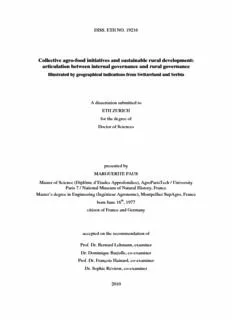
Collective agro-food initiatives and sustainable rural development PDF
Preview Collective agro-food initiatives and sustainable rural development
ETH Library Collective agro-food initiatives and sustainable rural development Articulation between internal governance and rural governance illustrated by geographical indications from Switzerland and Serbia Doctoral Thesis Author(s): Paus, Marguerite Publication date: 2010 Permanent link: https://doi.org/10.3929/ethz-a-006416325 Rights / license: In Copyright - Non-Commercial Use Permitted This page was generated automatically upon download from the ETH Zurich Research Collection. For more information, please consult the Terms of use. DISS. ETH NO. 19216 Collective agro-food initiatives and sustainable rural development: articulation between internal governance and rural governance Illustrated by geographical indications from Switzerland and Serbia A dissertation submitted to ETH ZURICH for the degree of Doctor of Sciences presented by MARGUERITE PAUS Master of Science (Diplôme d’Etudes Approfondies), AgroParisTech / University Paris 7 / National Museum of Natural History, France Master’s degree in Engineering (Ingénieur Agronome), Montpellier SupAgro, France born June 16th, 1977 citizen of France and Germany accepted on the recommendation of Prof. Dr. Bernard Lehmann, examiner Dr. Dominique Barjolle, co-examiner Prof. Dr. François Hainard, co-examiner Dr. Sophie Réviron, co-examiner 2010 DISS. ETH NO. 19216 Collective agro-food initiatives and sustainable rural development: articulation between internal governance and rural governance Illustrated by geographical indications from Switzerland and Serbia A dissertation submitted to ETH ZURICH for the degree of Doctor of Sciences presented by MARGUERITE PAUS Master of Science (Diplôme d’Etudes Approfondies), AgroParisTech / University Paris 7 / National Museum of Natural History, France Master’s degree in Engineering (Ingénieur Agronome), Montpellier SupAgro, France born June 16th, 1977 citizen of France and Germany accepted on the recommendation of Prof. Dr. Bernard Lehmann, examiner Dr. Dominique Barjolle, co-examiner Prof. Dr. François Hainard, co-examiner Dr. Sophie Réviron, co-examiner 2010 Table of contents Summary ........................................................................................................................... vi(cid:1) Résumé ............................................................................................................................ viii(cid:1) 1(cid:1) General introduction .................................................................................................... 1(cid:1) 1.1(cid:1) Theoretical background ........................................................................................ 4(cid:1) 1.1.1(cid:1) Collective agro-food initiatives ................................................................... 4(cid:1) 1.1.2(cid:1) Sustainable rural development .................................................................. 12(cid:1) 1.1.3(cid:1) Territorial Impact Assessment .................................................................. 18(cid:1) 1.1.4(cid:1) Facilitation ................................................................................................. 25(cid:1) 1.1.5(cid:1) Conclusion ................................................................................................. 30(cid:1) 1.2(cid:1) Research questions and objectives ...................................................................... 31(cid:1) 1.2.1(cid:1) General research choices ........................................................................... 31(cid:1) 1.2.2(cid:1) Research questions .................................................................................... 33(cid:1) 1.3(cid:1) Methodology ....................................................................................................... 34(cid:1) 1.4(cid:1) Serbian context ................................................................................................... 39(cid:1) 1.4.1(cid:1) Generalities ................................................................................................ 39(cid:1) 1.4.2(cid:1) Rural development context ........................................................................ 40(cid:1) 1.4.3(cid:1) Serbian agricultural and agro-food sectors ................................................ 41(cid:1) 1.4.4(cid:1) Geographical indications in Serbia ........................................................... 44(cid:1) 1.5(cid:1) Structure of the thesis ......................................................................................... 47(cid:1) 2(cid:1) Geographical Indications in Transition Countries and their Governance. Evidence from Serbian Agro-food Initiatives .......................................................... 49(cid:1) Abstract ........................................................................................................................ 50(cid:1) 2.1(cid:1) Introduction ......................................................................................................... 50(cid:1) i 2.2(cid:1) Governance forms of geographical indications .................................................. 51(cid:1) 2.2.1(cid:1) Governance structure and hybrid forms .................................................... 51(cid:1) 2.2.2(cid:1) Governance and territorial vs. sectoral strategies ...................................... 53(cid:1) 2.2.3(cid:1) Organisational forms and governance strategy ......................................... 54(cid:1) 2.3(cid:1) Why vertically integrate? .................................................................................... 55(cid:1) 2.4(cid:1) Presentation of the case studies and comparison ................................................ 57(cid:1) 2.4.1(cid:1) Context ...................................................................................................... 57(cid:1) 2.4.2(cid:1) Kajmak from Kraljevo .............................................................................. 57(cid:1) 2.4.3(cid:1) Raspberries from Arilje ............................................................................. 58(cid:1) 2.4.4(cid:1) Comparison of the cases ............................................................................ 59(cid:1) 2.5(cid:1) Discussion ........................................................................................................... 61(cid:1) 2.5.1(cid:1) Concurrent sourcing and market power .................................................... 61(cid:1) 2.5.2(cid:1) Potential evolution of governance ............................................................. 63(cid:1) 2.6(cid:1) Conclusion .......................................................................................................... 65(cid:1) 3(cid:1) Facilitating the Emergence of a Collective Initiative. Role and Leadership Style of Facilitators in Emergent Geographical Indications ................................................ 67(cid:1) Abstract ........................................................................................................................ 68(cid:1) 3.1.(cid:1) Introduction ......................................................................................................... 68(cid:1) 3.2(cid:1) On the concepts of “facilitator” and “leadership” .............................................. 69(cid:1) 3.2.1(cid:1) Definition of “facilitator” .......................................................................... 69(cid:1) 3.2.2(cid:1) Analytical framework to analyse the interaction of the “facilitator-group- context” ..................................................................................................... 70(cid:1) 3.2.3(cid:1) Facilitation and leadership’s style ............................................................. 75(cid:1) 3.3(cid:1) GIs and facilitation ............................................................................................. 77(cid:1) 3.3.1(cid:1) Governance structure of established GI organisations .............................. 77(cid:1) 3.3.2(cid:1) Reasons for producers to join the collective organisation ......................... 78(cid:1) 3.3.3(cid:1) GI systems and facilitation ........................................................................ 78(cid:1) ii 3.3.4(cid:1) Motivation and goals in GIs systems ........................................................ 79(cid:1) 3.4(cid:1) Method and case studies presentation ................................................................. 80(cid:1) 3.4.1(cid:1) Materials and method ................................................................................ 80(cid:1) 3.4.2(cid:1) Presentation of the GIs and the facilitation process .................................. 81(cid:1) 3.5(cid:1) Results ................................................................................................................. 86(cid:1) 3.5.1(cid:1) Competence building ................................................................................. 86(cid:1) 3.5.2(cid:1) Structuring the group ................................................................................. 86(cid:1) 3.5.3(cid:1) Catalysing the group process ..................................................................... 87(cid:1) 3.5.4(cid:1) Mobilising external resources ................................................................... 88(cid:1) 3.5.5(cid:1) Capacity building at institutional level ...................................................... 88(cid:1) 3.6(cid:1) Discussion ........................................................................................................... 90(cid:1) 3.7(cid:1) Conclusion .......................................................................................................... 95(cid:1) 4.(cid:1)Measure of the Territorial Impact of Agro-food Initiatives: Lessons from two Swiss case studies ........................................................................................................ 98(cid:1) Abstract ........................................................................................................................ 99(cid:1) 4.1(cid:1) Introduction ......................................................................................................... 99(cid:1) 4.2(cid:1) Territorial impact and Swiss policy on regional development ......................... 100(cid:1) 4.3(cid:1) State of the art – A prolific research field ......................................................... 101(cid:1) 4.3.1(cid:1) “Objective” methods ............................................................................... 102(cid:1) 4.3.2(cid:1) “Subjective” methods .............................................................................. 106(cid:1) 4.4(cid:1) Presentation of a survey - The acknowledgement of territorial impact ............ 108(cid:1) 4.4.1(cid:1) Method .................................................................................................... 108(cid:1) 4.4.2(cid:1) Results for the Rye Bread of Valais PDO ............................................... 109(cid:1) 4.4.3(cid:1) Results for Natura Beef ........................................................................... 113(cid:1) 4.5(cid:1) Discussion ......................................................................................................... 116(cid:1) 4.5.1(cid:1) Comparative analysis of the results ......................................................... 116(cid:1) 4.5.2(cid:1) Methodological aspects ........................................................................... 117(cid:1) iii 4.6(cid:1) Conclusion ........................................................................................................ 119(cid:1) Annex 1: The Swiss agricultural policy ..................................................................... 120(cid:1) Annex 2: Detail of the method ................................................................................... 122(cid:1) 5(cid:1) Territorial Impact of Geographical Indications. Review of Methods and Empirical Evidences ................................................................................................. 124(cid:1) Abstract ...................................................................................................................... 125(cid:1) 5.1(cid:1) Introduction ....................................................................................................... 126(cid:1) 5.2(cid:1) Review of Methods ........................................................................................... 127(cid:1) 5.2.1(cid:1) Generalities .............................................................................................. 127(cid:1) 5.2.2(cid:1) “Objective” methods ............................................................................... 128(cid:1) 5.2.3(cid:1) “Subjective” methods .............................................................................. 133(cid:1) 5.2.4(cid:1) Discussion of the review of methods ...................................................... 134(cid:1) 5.3(cid:1) Empirical evidences .......................................................................................... 135(cid:1) 5.3.1(cid:1) Case study methodology for data collection ........................................... 135(cid:1) 5.3.2(cid:1) Evaluation of the fourteen case studies ................................................... 136(cid:1) 5.4(cid:1) Discussion and conclusion ................................................................................ 141(cid:1) 6(cid:1) Synthesis and concluding remarks ......................................................................... 145(cid:1) 6.1(cid:1) General conclusions and discussion ................................................................. 145(cid:1) 6.2(cid:1) Identified dilemmas and recommendations ...................................................... 154(cid:1) 6.3(cid:1) Outlook for further research ............................................................................. 157(cid:1) 6.3.1(cid:1) Link between governance structure, territorial strategy and positive territorial effects ...................................................................................... 157(cid:1) 6.3.2(cid:1) Role of competition in GIs’ development ............................................... 159(cid:1) 6.3.3(cid:1) Impact assessment ................................................................................... 159(cid:1) 6.3.4(cid:1) Analysis of the scaling-up process .......................................................... 163(cid:1) 6.3.5(cid:1) Role of facilitation ................................................................................... 165(cid:1) iv References ...................................................................................................................... 172(cid:1) Acknowledgements ....................................................................................................... 193(cid:1) v
Description: